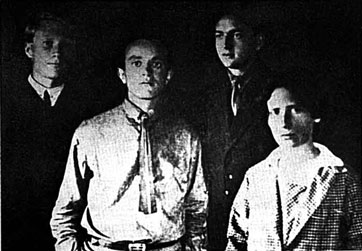As I recently discovered, my GrandmaТs older son, who was MishaТs father and my uncle, Alexander Nikolayevich, used to be an active member of RSDRP (without the УBФ, that is, not a Bolshevik).
He was arrested for the first time at the age of 17 or 18 and executed by a firing squad in 1938 in Saratov. Grandma probably did not find out about his passing until she was on her deathbed in 1943, and somehow she had always kept her hopes up for him.
His name was on a list of those condemned to be shot, a list handed over to the Military Tribunal of the 1st Category, signed by Stalin on September 12, 1938.
Once the signatures were in place, (Stalin, Molotov & ZhdanovТs), the УtrialФ itself took but ten minutes. The sentence, execution by a firing squad, was carried out on the same day, October 27, 1938.

A group of exiled. Parabel (Narym), 1927.
From left to right: A. Zimin. I. Rapiport, M. Kompaneetz, Kh. Shapiro (a Zionist, the rest Ц S-D).
I only know of one photograph of Alexander Zimin, and it was of poor quality. I copied it from the book УMemory, Historical Anthology є3,Ф published in Paris by YMCA Press in 1980.
There is a curious inscription on the title page: УThis anthology was completed in Moscow in June of 1978.Ф
I discovered in this book the following recollections of my uncle in a big article by T. Til, УThe Socialist-Democratic Youth Movement in the 1920Тs:
УЕon Alexander Zimin. He was a very attractive and sincere man. I had the impression that he belonged to the category of Уmerry melancholicsФ: УLively, witty, he would write humorous poems in Russian and French for the amusement of his friends, being at the same time a very impressionable and vulnerable person. He was arrested for the first time in 1921; after 7 or 8 months of confinement in the
Butyrskaya and Orlovskaya prisons he was released, but in 5 months arrested again and exiled to the Orlov region, whence he escaped.
He was arrested again, and again escaped, this time from prison. He worked in the Rostov S-D organization until the fall of 1923.
In September of the same year he was arrested at the Irpen conference, and this time around he was sentenced to three years in prison. From 1923 on, things followed a pattern: 3 years of prison, 3 years of exile to the Narym region, then living on the lam for a while, interrupted by a new arrest Ц but this time getting off with only a very short stay in the interrogation jail.
In 1931 came another arrest and 3 years of imprisonment in the Upper-Ural isolation jail for political prisoners.
Later, 3 years of exile, again in Narym region, more life on the lam in Saratov, where he was arrested for the last time in 1937. He died the same year. Did he die during interrogation, or on the march; was he shot, or did he take his own life? All outcomes are equally probable.Ф